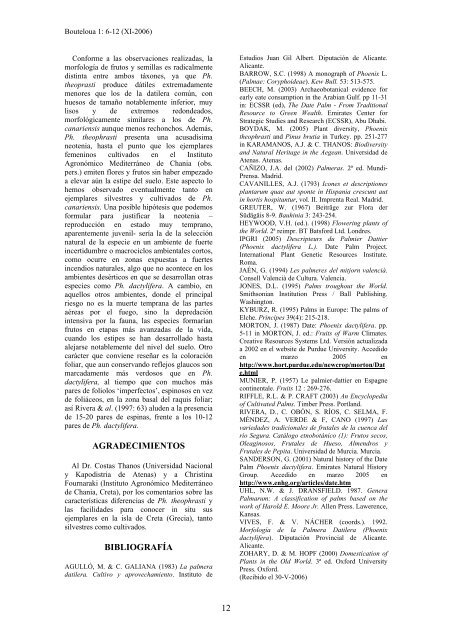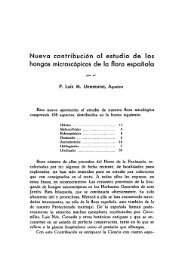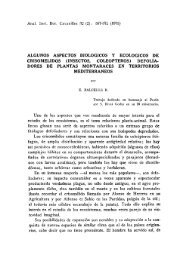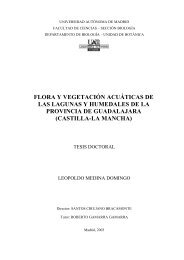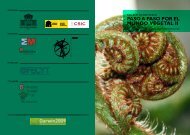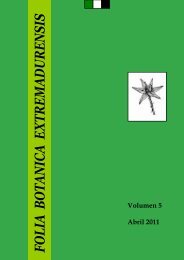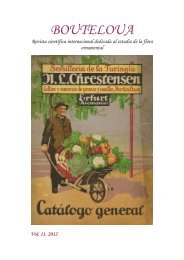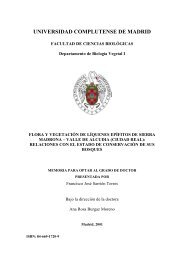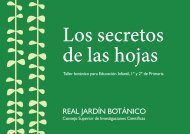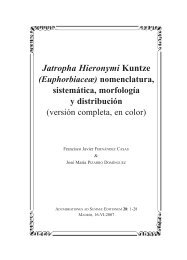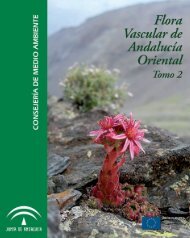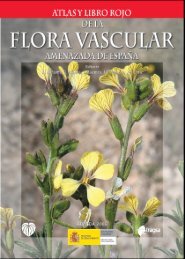Bouteloua 1: 6-12 (XI-2006)Conforme a las observaciones realizadas, lamorfología <strong>de</strong> frutos y semillas es radicalmentedistinta entre ambos táxones, ya que Ph.theoprasti produce dátiles extremadamentemenores que los <strong>de</strong> la datilera común, conhuesos <strong>de</strong> tamaño notablemente inferior, muylisos y <strong>de</strong> extremos redon<strong>de</strong>ados,morfológicamente similares a los <strong>de</strong> Ph.canariensis aunque menos rechonchos. A<strong>de</strong>más,Ph. theophrasti presenta una acusadísimaneotenia, hasta el punto que los ejemplaresfemeninos cultivados en el InstitutoAgronómico Mediterráneo <strong>de</strong> Chania (obs.pers.) emiten flores y frutos sin haber empezadoa elevar aún la estipe <strong><strong>de</strong>l</strong> suelo. Este aspecto lohemos observado eventualmente tanto enejemplares silvestres y cultivados <strong>de</strong> Ph.canariensis. Una posible hipótesis que po<strong>de</strong>mosformular para justificar la neotenia –reproducción en estado muy temprano,aparentemente juvenil- sería la <strong>de</strong> la selecciónnatural <strong>de</strong> la especie en un ambiente <strong>de</strong> fuerteincertidumbre o macrociclos ambientales cortos,como ocurre en zonas expuestas a fuertesincendios naturales, algo que no acontece en losambientes <strong>de</strong>sérticos en que se <strong>de</strong>sarrollan otrasespecies como Ph. dactylifera. A cambio, enaquellos otros ambientes, don<strong>de</strong> el principalriesgo no es la muerte temprana <strong>de</strong> las partesaéreas por el fuego, sino la <strong>de</strong>predaciónintensiva por la fauna, las especies formaríanfrutos en etapas más avanzadas <strong>de</strong> la vida,cuando los estipes se han <strong>de</strong>sarrollado hastaalejarse notablemente <strong><strong>de</strong>l</strong> nivel <strong><strong>de</strong>l</strong> suelo. Otrocarácter que conviene reseñar es la coloraciónfoliar, que aun conservando reflejos glaucos sonmarcadamente más verdosos que en Ph.dactylifera, al tiempo que con muchos máspares <strong>de</strong> foliolos ‘imperfectos’, espinosos en vez<strong>de</strong> foliáceos, en la zona basal <strong><strong>de</strong>l</strong> raquis foliar;así Rivera & al. (1997: 63) alu<strong>de</strong>n a la presencia<strong>de</strong> 15-20 pares <strong>de</strong> espinas, frente a los 10-12pares <strong>de</strong> Ph. dactylifera.AGRADECIMIENTOSAl Dr. Costas Thanos (Universidad Nacionaly Kapodistria <strong>de</strong> Atenas) y a ChristinaFournaraki (Instituto Agronómico Mediterráneo<strong>de</strong> Chania, Creta), por los comentarios sobre lascaracterísticas diferencias <strong>de</strong> Ph. theophrasti ylas facilida<strong>de</strong>s para conocer in situ susejemplares en la isla <strong>de</strong> Creta (Grecia), tantosilvestres como cultivados.BIBLIOGRAFÍAAGULLÓ, M. & C. GALIANA (1983) La palmeradatilera. Cultivo y aprovechamiento. Instituto <strong>de</strong>Estudios Juan Gil Albert. Diputación <strong>de</strong> Alicante.Alicante.BARROW, S.C. (1998) A monograph of Phoenix L.(Palmae: Coryphoi<strong>de</strong>ae). Kew Bull. 53: 513-575.BEECH, M. (2003) Archaeobotanical evi<strong>de</strong>nce forearly eate consumption in the Arabian Gulf. pp 11-31in: ECSSR (ed), The Date Palm - From TraditionalResource to Green Wealth. Emirates Center forStrategic Studies and Research (ECSSR), Abu Dhabi.BOYDAK, M. (2005) Plant diversity, Phoenixtheophrasti and Pinus brutia in Turkey. pp. 251-277in KARAMANOS, A.J. & C. THANOS: Biodiversityand Natural Heritage in the Aegean. Universidad <strong>de</strong>Atenas. Atenas.CAÑIZO, J.A. <strong><strong>de</strong>l</strong> (2002) Palmeras. 2ª ed. Mundi-Prensa. <strong>Madrid</strong>.CAVANILLES, A.J. (1793) Icones et <strong>de</strong>scriptionesplantarum quae aut sponte in Hispania crescunt autin hortis hospitantur, vol. II. Imprenta <strong>Real</strong>. <strong>Madrid</strong>.GREUTER, W. (1967) Beiträge zur Flora <strong>de</strong>rSüdägäis 8-9. Bauhinia 3: 243-254.HEYWOOD, V.H. (ed.). (1998) Flowering plants ofthe World. 2ª reimpr. BT Batsford Ltd. Londres.IPGRI (2005) Descripteurs du Palmier Dattier(Phoenix dactylifera L.). Date Palm Project.International Plant Genetic Resources Institute.Roma.JAÉN, G. (1994) Les palmeres <strong><strong>de</strong>l</strong> mitjorn valencià.Consell Valencià <strong>de</strong> Cultura. Valencia.JONES, D.L. (1995) Palms troughout the World.Smithsonian Institution Press / Ball Publishing.Washington.KYBURZ, R. (1995) Palms in Europe: The palms ofElche. Principes 39(4): 215-218.MORTON, J. (1987) Date: Phoenix dactylifera. pp.5-11 in MORTON, J. ed.: Fruits of Warm Climates.Creative Resources Systems Ltd. Versión actualizadaa 2002 en el website <strong>de</strong> Purdue University. Accedidoen marzo 2005 enhttp://www.hort.purdue.edu/newcrop/morton/Date.htmlMUNIER, P. (1957) Le palmier-dattier en Espagnecontinentale. Fruits 12 : 269-276.RIFFLE, R.L. & P. CRAFT (2003) An Encyclopediaof Cultivated Palms. Timber Press. Portland.RIVERA, D., C. OBÓN, S. RÍOS, C. SELMA, F.MÉNDEZ, A. VERDE & F, CANO (1997) Lasvarieda<strong>de</strong>s tradicionales <strong>de</strong> frutales <strong>de</strong> la cuenca <strong><strong>de</strong>l</strong>río Segura. Catálogo etnobotánico (1): Frutos secos,Oleaginosos, Frutales <strong>de</strong> Hueso, Almendros yFrutales <strong>de</strong> Pepita. Universidad <strong>de</strong> Murcia. Murcia.SANDERSON, G. (2001) Natural history of the DatePalm Phoenix dactylifera. Emirates Natural HistoryGroup. Accedido en marzo 2005 enhttp://www.enhg.org/articles/date.htmUHL, N.W. & J. DRANSFIELD. 1987. GeneraPalmarum: A classification of palms based on thework of Harold E. Moore Jr. Allen Press. Lawerence,Kansas.VIVES, F. & V. NÁCHER (coords.). 1992.Morfología <strong>de</strong> la Palmera Datilera (Phoenixdactylifera). Diputación Provincial <strong>de</strong> Alicante.Alicante.ZOHARY, D. & M. HOPF (2000) Domestication ofPlants in the Old World. 3ª ed. Oxford UniversityPress. Oxford.(Recibido el 30-V-2006)12
D. GULLOT & P. VAN DER MEER: Claves para los distintos taxones cultivados como ornamentalesClaves para los distintos taxones cultivados comoornamentales en la Península Ibérica e Islas Baleares <strong>de</strong> laespecie Agave americana L.Daniel GUILLOT ORTIZ* & Piet Van DER MEER ***Jardín Botánico. Universidad <strong>de</strong> Valencia. C/. Quart 82. E-46008-Valencia.dguillot_36@hotmail.com**Camino Nuevo <strong>de</strong> Picaña sn, 46014. Picaña (Valencia). España.RESUMEN: En este artículo citamos los taxones pertenecientes la especie Agave americana L., cultivados comoornamentales en la Península Ibérica e Islas Baleares, así como mostramos unas claves clasificatorias.ABSTRACT: In this article we cite the cultivated taxa of Agave americana L. in Spain, and show dicotomic keys.INTRODUCCIÓNLa especie A. americana L. es muy conocida ysu presencia en Europa está ampliamentedocumentada <strong>de</strong>s<strong>de</strong> épocas posteriores a laconquista. Se trata <strong>de</strong> un taxón alóctono, que enlos últimos siglos ha pasado a ser un elementohabitual <strong><strong>de</strong>l</strong> paisaje valenciano. El género AgaveL. llegó a Europa probablemente con CristobalColón en 1492-93, pero es en 1520 cuando locita Charles <strong>de</strong> l´Ecluse, en Valencia, y suprimera floración data <strong>de</strong> 1561, como cita J. A.Cortuso. Des<strong>de</strong> el punto <strong>de</strong> vista histórico, en laPenínsula Ibérica encontramos numerosasreferencias <strong>de</strong> este género, principalmente <strong>de</strong>esta especie, tanto <strong>de</strong> autores <strong><strong>de</strong>l</strong> siglo XX,como <strong>de</strong> siglos anteriores. Por ejemplo,Cavanilles (1795), en una litografía don<strong>de</strong>representa el “Uso <strong>de</strong> la pita y vista <strong><strong>de</strong>l</strong>aqüeducto <strong>de</strong> Canals”, nos muestra unaplantación <strong>de</strong> Agave americana, y dostrabajadores cortando las hojas y extrayendo lafibra. Labor<strong>de</strong> (1826), apunta que las pitas“Crecen naturalmente por las orillas <strong>de</strong> loscaminos, y ribazos <strong>de</strong> los campos, <strong>de</strong> las cualessacan un hilo para fabricar cordones y algunostejidos”. Colmeiro (1846) la indica como“Naturalizada y <strong>de</strong>stinada á circuir loscampos” en Cataluña. Cutanda & Amo (1848)indican A. americana y la var. variegata:“Hojas con la márgen amarilla ó blanca …”.Sadaba & Angulo (1885) citan la especie A.americana y la var. variegata, y nos aportaninformación sobre esta planta en España:“Hojas con la margen amarilla ó blanca.Originaria <strong>de</strong> América e introducida porCortuso en Europa, en 1561, hállaseconnaturalizada y subespontánea en muchasprovincias españolas <strong>de</strong> Levante y Mediodia,especialmente en Valencia, Alicante yprovincias andaluzas, don<strong>de</strong> se utiliza paracercar hereda<strong>de</strong>s. Rara vez se la ve en flor ennuestros climas, y nosotros la hemos visto, en1865, en el Botánico <strong>de</strong> <strong>Madrid</strong>, en algunospiés, proce<strong>de</strong>ntes <strong>de</strong> la época <strong>de</strong> la instalación<strong><strong>de</strong>l</strong> jardín, en tiempo <strong>de</strong> Carlos III”. Otro autorespañol, Amo (1871), nos proporciona másdatos sobre el área <strong>de</strong> cultivo <strong>de</strong> esta especie enEspaña: “Esta especie es la pita americana, queen las provincias <strong><strong>de</strong>l</strong> Mediodía y <strong><strong>de</strong>l</strong> Orientesirve para formar setos vivos en unión <strong>de</strong> lanopalera ó Higuera Chumba. Vive también enla región central <strong>de</strong> nuestro territorio enparages abrigados, como igualmente en ellitoral <strong>de</strong> Galicia”.En el siglo XIX era cultivada enprácticamente toda la Península Ibérica. Costa(1877) indica la presencia <strong>de</strong> A. americana“Completamente naturalizada y <strong>de</strong>stinada acircuir los predios en las costas y en sitiosabrigados <strong><strong>de</strong>l</strong> interior, como la falda <strong><strong>de</strong>l</strong>Monseny, cercanias <strong>de</strong> Vich, Olot, etc.”.Bellynck (1883-85) también la cita. En elinterior <strong>de</strong> la península, por ejemplo, Pardo(1895) indica este taxón en Torrecilla <strong>de</strong>Alcañíz, Zaragoza: “Algún pie cultivado ó a lomenos traído <strong>de</strong> muy lejos por curiosidad, quese sostiene y medra algo”. Cortés (1885)incluye datos <strong>de</strong> numerosos taxones <strong><strong>de</strong>l</strong> géneroAgave, incluida esta especie, con las cv.´Mediopicta`, ´Striata` y ´Variegata`. En lossiglos XVIII y XIX, el género es ampliamenterepresentado en diversas obras pictóricas, loque po<strong>de</strong>mos observar en litografías recogidaspor Freixa (1993), Cabra (1994) y Soler (1994)formando parte <strong><strong>de</strong>l</strong> paisaje. De este taxón hansido citados numerosas subespecies, varieda<strong>de</strong>sy cultivarieda<strong>de</strong>s, siendo la más conocida yampliamente distribuida A. americana var.americana. Según Gentry (1982), el progenitor<strong>de</strong> los cultivares es la subsp. protamericana,que crece naturalmente en la Sierra MadreOriental, en bosques tropicales caducifolios yzonas <strong>de</strong> bosques en elevaciones <strong>de</strong> 500-1400metros. Se distribuye a lo largo <strong>de</strong> la zona este13
- Page 1 and 2: BOUTELOUAREVISTA CIENTÍFICA INTERN
- Page 3 and 4: ÍNDICEBreve nota biográfica de Es
- Page 5 and 6: D. GUILLOT ORTIZ: Breve nota biogr
- Page 7 and 8: E. LAGUNA LUMBRERAS: Las especies c
- Page 9 and 10: E. LAGUNA LUMBRERAS: Las especies c
- Page 11: E. LAGUNA LUMBRERAS: Las especies c
- Page 15 and 16: D. GULLOT & P. VAN DER MEER: Claves
- Page 17 and 18: D. GULLOT & P. VAN DER MEER: Claves
- Page 19 and 20: D. GULLOT & P. VAN DER MEER: Claves
- Page 21 and 22: E. LAGUNAS LUMBRERAS: De los nombre
- Page 23 and 24: E. LAGUNAS LUMBRERAS: De los nombre
- Page 25 and 26: D. GUILLOT, G. MATEO & A. ROSSELLÓ
- Page 27 and 28: D. GUILLOT, G. MATEO & A. ROSSELLÓ
- Page 29 and 30: D. GUILLOT, G. MATEO & A. ROSSELLÓ
- Page 31 and 32: D. GUILLOT, G. MATEO & A. ROSSELLÓ
- Page 33 and 34: D. GUILLOT, G. MATEO & A. ROSSELLÓ
- Page 35 and 36: E. SÁNCHEZ GULLÓN: Aproximación
- Page 37 and 38: E. SÁNCHEZ GULLÓN: Aproximación
- Page 39 and 40: E. SÁNCHEZ GULLÓN: Aproximación
- Page 41 and 42: E. SÁNCHEZ GULLÓN: Aproximación
- Page 43 and 44: J.I. DE JUANA CLAVERO: El dilema Li
- Page 45 and 46: J.I. DE JUANA CLAVERO: El dilema Li
- Page 47 and 48: D. GUILLOT ORTIZ: Abies pinsapo cv.
- Page 49 and 50: M. CHAZARO-BASAÑEZ & R. RAMOS-FLOR
- Page 51 and 52: M. CHAZARO-BASAÑEZ & R. RAMOS-FLOR
- Page 53 and 54: D. GUILLOT & P. VAN DER MEER: Tres
- Page 55 and 56: F. VERLOOVE:Exotic grasses running
- Page 57 and 58: F. VERLOOVE:Exoctic grasses running
- Page 59 and 60: F. VERLOOVE:Exoctic grasses running
- Page 61 and 62: D. GUILLOT & J.A. ROSSELLÓ: Un nue
- Page 63 and 64:
D. GUILLOT, P. VAN DER MEER & L. ES
- Page 65 and 66:
D. GUILLOT, P. VAN DER MEER & L. ES
- Page 67 and 68:
D. GUILLOT, P. VAN DER MEER & L. ES
- Page 69 and 70:
D. GUILLOT, P. VAN DER MEER & L. ES
- Page 71 and 72:
Notas brevescitado anteriormente co
- Page 73 and 74:
Notas brevesNueva Guinea, este de A
- Page 75 and 76:
Reseñas bibliográficasReseñas bi
- Page 77 and 78:
A. ORTUÑO: Jardines históricos es
- Page 79 and 80:
A. ORTUÑO: Jardines históricos es
- Page 81 and 82:
A. ORTUÑO: Jardines históricos es
- Page 83 and 84:
A. ORTUÑO: Jardines históricos es
- Page 85 and 86:
A. ORTUÑO: Jardines históricos es
- Page 87 and 88:
A. ORTUÑO: Jardines históricos es
- Page 89 and 90:
A. ORTUÑO: Jardines históricos es
- Page 92:
BOUTELOUAVOLUMEN 1. XI-2006 - ISSN


